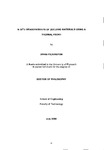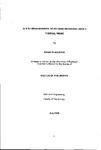In situ measurements of building materials using a thermal probe
| dc.contributor.author | Pilkington, Brian | |
| dc.contributor.other | School of Engineering, Computing and Mathematics | en_US |
| dc.date.accessioned | 2011-09-22T14:17:37Z | |
| dc.date.available | 2011-09-22T14:17:37Z | |
| dc.date.issued | 2008 | |
| dc.date.issued | 2008 | |
| dc.identifier | Not available | en_US |
| dc.identifier.uri | http://hdl.handle.net/10026.1/612 | |
| dc.description | Access to the full version of this thesis is unavailable due to third party copyright restrictions | |
| dc.description | Merged with duplicate record 10026.1/2243 on 13.03.2017 by CS (TIS) | |
| dc.description.abstract |
This work concerns the in situ measurement of thermal conductivity and thermal diffusivity of building materials, so as to provide improved data for the estimation and prediction of energy efficiency in buildings. Thermal data sources and measurement methods currently used by industry to inform building design were found to give flawed values for the thermal properties of materials as found in situ. A transient measurement technique, carried out by means of a thermal probe, and used in various other industries, was investigated as an alternative, relatively non-destructive, rapid and economic means of obtaining representative results. An analysis of the literature associated with the technique's history, theory and practice was carried out. Four strands of scientific research were undertaken: traditional thermal probe solutions were assessed; computer simulations were used to model probe behaviour while avoiding practical, experimental error; laboratory based measurements were carried out with materials of known and unknown thermal properties using varied parameters, including moisture content; an apparatus was developed for fieldwork, and in situ measurements were carried out on real buildings, using novel analysis routines. Results for thermal diffusivity values achieved by the thermal probe method were found to be unreliable. Representative thermal conductivity values were achieved for structural materials with varied moisture content, both in controlled laboratory environments and in situ under diverse environmental conditions, which had not previously been achieved. Heat losses from the probe open end and the material adjacent to it were shown to currently prevent reliable values being obtained for building insulation materials. The thermal probe technique was successfully transferred from laboratory to in situ measurements. It was shown that various calibration factors reported in the literature could not be relied upon to transfer successfully between material types. A significant cause of error in the measurement of insulation materials was identified and a guarded probe was proposed to overcome this. The technique was shown to provide much improved thermal conductivity data for structural building materials, whether as samples or in situ, with the potential to expand this success to insulation materials in the future. | en_US |
| dc.language.iso | en | en_US |
| dc.publisher | University of Plymouth | en_US |
| dc.title | In situ measurements of building materials using a thermal probe | en_US |
| dc.type | Thesis | |
| dc.identifier.doi | http://dx.doi.org/10.24382/4771 |
Files in this item
This item appears in the following Collection(s)
-
01 Research Theses Main Collection
Research Theses Main



